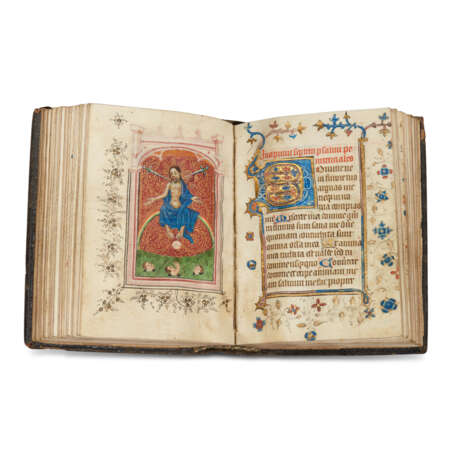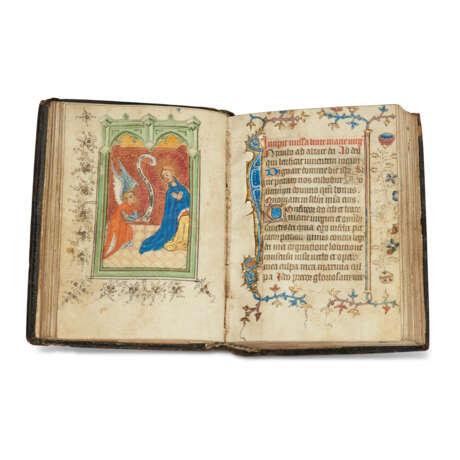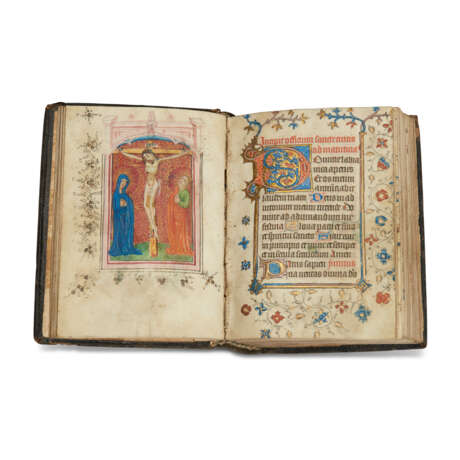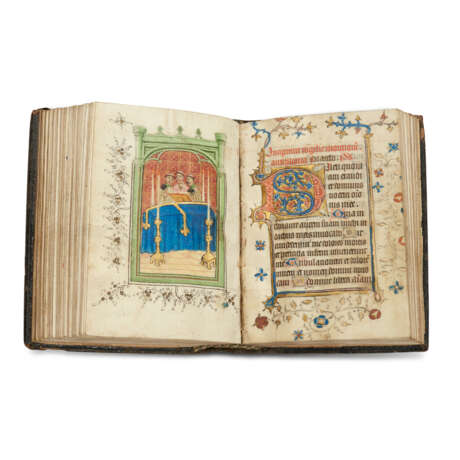ID 870803
Lot 38 | Anonymous Bruges artist
Estimate value
£ 12 000 – 18 000
Book of Hours, use of Rome, in Latin, illuminated manuscript on vellum [Bruges, c.1400-1415]
A petite Book of Hours painted in Bruges at the beginning of the 15th century with five fine full-page miniatures by the same artist responsible for Nürnberg Stadtbibliothek Hert. Ms. 3.
104 x 80mm. 160 + i, collation: 112, 29 (of 8, i an inserted miniature), 39 (of 8, i an inserted miniature), 49 (ix a singleton), 59 (of 8, i an inserted miniature), 6-98, 1010 (of 12, xi-xii cancelled blanks), 114, 129 (of 9, i an inserted miniature), 138, 149 (of 8, i an inserted miniature), 15-188, 19-204, 15 lines, ruled space: 65 x 42mm, rubrics in red, one-line initials alternating blue and liquid gold and two-line illuminated initials on blue grounds throughout, 14 illuminated initials with borders of bars, ivy and hairline tendrils supporting flowers and gold discs, five full-page miniatures within frames topped with architectural arches with border decoration of gold discs on hairline tendrils (a little cropped, scattered light staining throughout). 17th-century ?sheep (rubbed, small losses at corners and spine).
Provenance:
(1) The illumination shows that our manuscript was made in Bruges in the first years of the 15th century: the Virgin of Humility on f.39v, shown seated on a cushion with her feet on a crescent moon, is an iconographical choice distinct to Bruges. The liturgical use – of Rome, not Sarum – and an absence of English saints such as Edmund, Oswald and Hugh of Lincoln in the Calendar suggests that these Hours were not destined for export to England, unlike many produced in Bruges at the time. The unusual inclusion of the Italian saint Proculus of Bologna in the Litany, placed a prominent second in the list of martyrs, might point instead to an Italian patron.
(2) A 17th-century owner has added a plea for intercession beneath the Virgin and Child miniature.
Contents:
Calendar ff.1-12; Hours of the Cross ff.14-16; Hours of the Spirit ff.17-20; ruled blank f.21; Mass of the Virgin ff.23-28; Gospel extracts ff.28-32v; O intemerata ff.33-35; Obsecro te ff.35v-39; Hours of the Virgin, use of Rome ff.41-93v : matins f.41, lauds f.51, prime f.69, terce f.72v, sext f.76, none f.79, vespers f.82, compline f.90v; ruled blank f.94; Penitential Psalms ff.96-111; Office of the Dead ff.113-159; ruled blank f.160.
The wording of the rubric introducing the Hours of the Virgin, 'secundum consuetudinem sacrosanctae romanae ecclesie', is unusual: 'secundum usum romane ecclesie' or 'secundum consuetudinem romane ecclesie' would be more conventional.
Illumination:
The cool palette, rather stiff figures, and a preference for red backgrounds link these Hours stylistically to the 'Ushaw Group', active at the beginning of the 15th century in Bruges, the most important centre of manuscript production in the Netherlands at this time. Named for a Book of Hours in Durham (Ushaw College MS 10) with a colophon by the copyist Johannes Heineman stating that it was written in Bruges and completed in January 1409, the Ushaw Group were responsible for a wide corpus of manuscripts dateable to roughly 1400-1415 (for the Ushaw Group and Bruges manuscripts of the period, see M. Smeyers, Flemish Miniatures, 1999, pp. 194-214). Our manuscript seems to have been painted by the same artist as a Book of Hours now in Nürnberg (Stadtbibliothek, Hert. Ms. 3; see Smeyers, p.198): the use of a firm black line to outline the upper eyelids and the draughtsman-like treatment of the architectural arches above the miniature frames are closely comparable.
The subjects of the inserted full-page miniatures are as follows: Crucifixion f.13v; Annunciation f.22v; Virgin of Humility f.39v; Last Judgement f.94v; Funeral Mass f.111v.
Special notice
No VAT on hammer price or buyer's premium.
| Place of origin: | Belgium, Western Europe, Europe |
|---|---|
| Auction house category: | Medieval & renaissance manuscripts |
| Place of origin: | Belgium, Western Europe, Europe |
|---|---|
| Auction house category: | Medieval & renaissance manuscripts |
| Address of auction |
CHRISTIE'S 8 King Street, St. James's SW1Y 6QT London United Kingdom | |
|---|---|---|
| Preview |
| |
| Phone | +44 (0)20 7839 9060 | |
| Buyer Premium | see on Website | |
| Conditions of purchase | Conditions of purchase |






